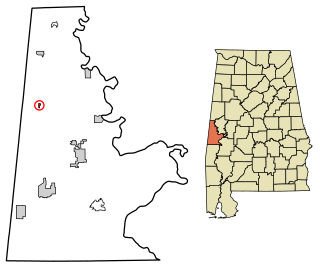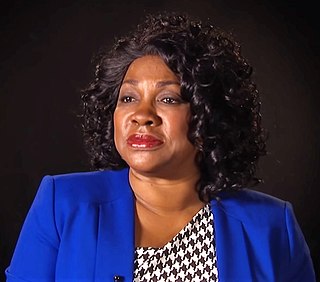
Emelle is a town in Sumter County, Alabama, United States. It was named after the daughters of the man who donated the land for the town. The town was started in the 19th century but not incorporated until 1981. The daughters of the man who donated were named Emma Dial and Ella Dial, so he combined the two names to create Emelle. Emelle was famous for its great cotton. The first mayor of Emelle was James Dailey. He served two terms. The current mayor is Roy Willingham Sr. The population was 32 at the 2020 census.
Ecological modernization is a school of thought that argues that both the state and the market can work together to protect the environment. It has gained increasing attention among scholars and policymakers in the last several decades internationally. It is an analytical approach as well as a policy strategy and environmental discourse.

Superfund is a United States federal environmental remediation program established by the Comprehensive Environmental Response, Compensation, and Liability Act of 1980 (CERCLA). The program is administered by the Environmental Protection Agency (EPA). The program is designed to investigate and clean up sites contaminated with hazardous substances. Sites managed under this program are referred to as Superfund sites. There are 40,000 federal Superfund sites across the country, and approximately 1,300 of those sites have been listed on the National Priorities List (NPL). Sites on the NPL are considered the most highly contaminated and undergo longer-term remedial investigation and remedial action (cleanups).

The Theory of the Leisure Class: An Economic Study of Institutions (1899), by Thorstein Veblen, is a treatise of economics and sociology, and a critique of conspicuous consumption as a function of social class and of consumerism, which are social activities derived from the social stratification of people and the division of labor; the social institutions of the feudal period that have continued to the modern era.

Environmental racism, ecological racism or ecological apartheid is a form of institutional racism leading to landfills, incinerators, and hazardous waste disposal being disproportionately placed in communities of color. Internationally, it is also associated with extractivism, which places the environmental burdens of mining, oil extraction, and industrial agriculture upon indigenous peoples and poorer nations largely inhabited by people of color.
Environmental justice is a social movement to address environmental injustice, which is the exposure of poor and marginalized communities to harm from hazardous waste, resource extraction, and other land uses from which they do not receive benefits. The movement has generated hundreds of studies showing that exposure to environmental harm is inequitably distributed. One example of this is environmental racism. Environmental justice is the fair treatment and meaningful involvement of all people regardless of race, color, national origin, or income, with respect to the development, implementation, and enforcement of environmental laws, regulations, and policies. Fundamentally, the goal is to provide agency in environmental decisions to people of all demographics.

In land-use planning, a locally unwanted land use (LULU) is a land use that creates externality costs on those living in close proximity. These costs include potential health hazards, poor aesthetics, or reduction in home values. LULUs often gravitate to disadvantaged areas such as slums, industrial neighborhoods and poor, minority, unincorporated or politically under-represented places that cannot fight them off. Such facilities with such hazards need to be created for the greater benefits that they offer society.

Warren County PCB Landfill was a PCB landfill located in Warren County, North Carolina, near the community of Afton south of Warrenton. The landfill was created in 1982 by the State of North Carolina as a place to dump contaminated soil as result of an illegal PCB dumping incident. The site, which is about 150 acres (0.61 km2), was extremely controversial and led to years of lawsuits. Warren County was one of the first cases of environmental justice in the United States and set a legal precedent for other environmental justice cases. The site was approximately three miles south of Warrenton. The State of North Carolina owned about 19 acres (77,000 m2) of the tract where the landfill was located, and Warren County owned the surrounding acreage around the borders.

David Naguib Pellow is Dehlsen Chair and Professor of Environmental Studies and Director of the Global Environmental Justice Project at the University of California, Santa Barbara. Previously he was Professor, Don Martindale Endowed Chair, Department of Sociology, University of Minnesota and Associate Professor of Ethnic Studies at the University of California, San Diego. His area of specialisation include issues concerning environmental justice, race and ethnicity, labour, social protest, animal rights, immigration, free trade agreements, globalization, the global impacts of the high tech industry in Asia, Latin America and elsewhere.
Ecological design or ecodesign is an approach to designing products and services that gives special consideration to the environmental impacts of a product over its entire lifecycle. Sim Van der Ryn and Stuart Cowan define it as "any form of design that minimizes environmentally destructive impacts by integrating itself with living processes." Ecological design can also be defined as the process of integrating environmental considerations into design and development with the aim of reducing environmental impacts of products through their life cycle.

Robert Doyle Bullard is an American academic who is the former Dean of the Barbara Jordan - Mickey Leland School Of Public Affairs and currently Distinguished Professor at Texas Southern University. Previously Ware Professor of Sociology and Director of the Environmental Justice Resource Center at Clark Atlanta University, Bullard is known as the "father of environmental justice". He has been a leading campaigner against environmental racism, as well as the foremost scholar of the problem, and of the Environmental Justice Movement which sprung up in the United States in the 1980s.
McCastle v. Rollins is a case that was filed on behalf of the residents of Alsen, Louisiana against Rollins Environmental Services, Inc., and. Although the decision in this case allowed the plaintiffs within this community to be certified as a class, and allowed them to be viewed as a unit when filing their lawsuit, and thereby reversing the decision that had been made at the trial and appellate level, the case was not reheard in the lower courts. Instead, Rollins Environmental Services, Inc. settled with the plaintiffs outside of court in 1987. Although this case is primarily cited for what a group of people need to do in order to obtain class certification, it is also often cited as one of the pivotal moments in the Environmental justice grass roots movement that has been occurring within communities of color. The people involved in the suit look at the way in which their community was disproportionately impacted by toxic waste polluters in light of their race and class, in comparison to communities that are composed of people who are racially and economically privileged and advocated for more considerate treatment by state regulators and operators of waste disposal plants. Through looking at the development of the McCastle v. Rollins lawsuit, one can see the way in which class, race, legal claims, community activism, public health and environmentalism can be viewed and used in conjunction with one another to protect the rights of people living within a given community.
Toxic colonialism, or toxic waste colonialism, refers to the practice of exporting hazardous waste from developed countries to underdeveloped ones for disposal.
The global waste trade is the international trade of waste between countries for further treatment, disposal, or recycling. Toxic or hazardous wastes are often imported by developing countries from developed countries.
Greenaction for Health and Environmental Justice, formed in 1997, is a multiracial grassroots organization based in San Francisco that works with low-income and working class urban, rural, and indigenous communities. It runs campaigns in the United States to build grassroots networks, and advocate for social justice.
Douglas L. Anderton is an American sociologist and statistician. He is a Fellow of the American Association for Advancement of Science and the American Statistical Association, and an elected member of the Sociological Research Association and International Statistical Institute. He earned an B.S. in economics (1973), an M.S. in economics (1975), and a Ph.D. in sociology (1983), all from the University of Utah. At the University of Utah He worked on the human genetics research project with Dr. Lee L. Bean and Dr. Mark Skolnick, among others. He taught at the University of Chicago from 1983-1986, where he worked with Dr. Donald Bogue as an Associate Director of the Social Development Center. Then, he moved to the University of Massachusetts-Amherst where he taught from 1988 to 2012, serving first as Peter H. Rossi's Associate Director, as long time Director, of the Social and Demographic Research Institute, and as the College of Behavioral Sciences Associate Dean for Research. He taught at the University of South Carolina and served as Chair of the Department of Sociology from 2012-2020 and as an Associate Dean in 2020.
Concerned Citizens of South Central Los Angeles(CCSCLA) is a non-profit 501(c)3 community-based organization whose mission is to work for social justice and economic and environmental change within the South Central community. CCSCLA works to involve community members in identifying social, economic, and environmental areas of concern to them, and give them the tools necessary to engage with institutions, such as industries or political leaders, to enact change.

Paul Mohai is a Professor and Chair of the Resource Policy and Behavior Concentration at the University of Michigan. He co-established the University of Michigan's Environmental Justice Program and co-published one of the first major scholarly books that explored the links between race, class, and environmental hazards.

Beverly Wright is an American environmental justice scholar and the founder of the Deep South Center for Environmental Justice at Dillard University. Her research considers the environmental and health inequalities along the Mississippi River Chemical Corridor. Her awards and honours include the Environmental Protection Agency Environmental Justice Achievement Award.
Environmental racism is a form of institutional racism, in which people of colour bear a disproportionate burden of environmental harms, such as pollution from hazardous waste disposal and the effects of natural disasters. Environmental racism exposes Native Americans, African Americans, Asian Americans, Pacific Islanders, and Hispanic populations to physical health hazards and may negatively impact mental health. It creates disparities in many different spheres of life, such as transportation, housing, and economic opportunity.










